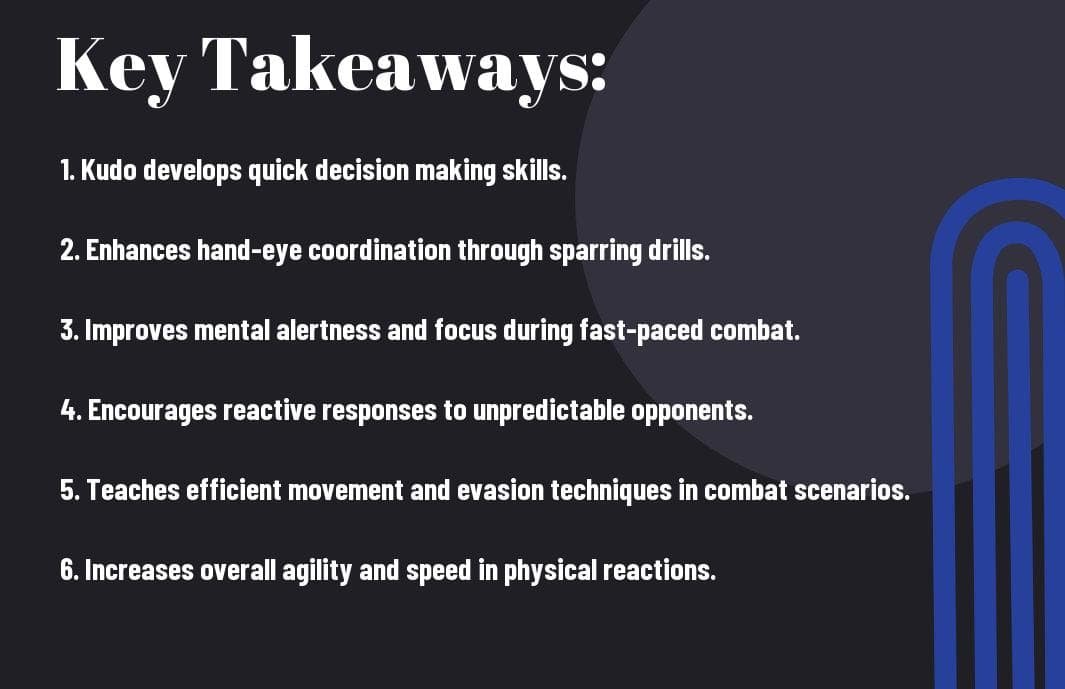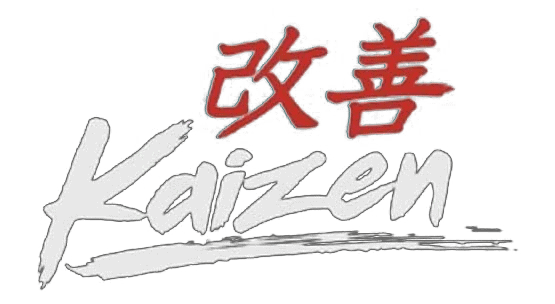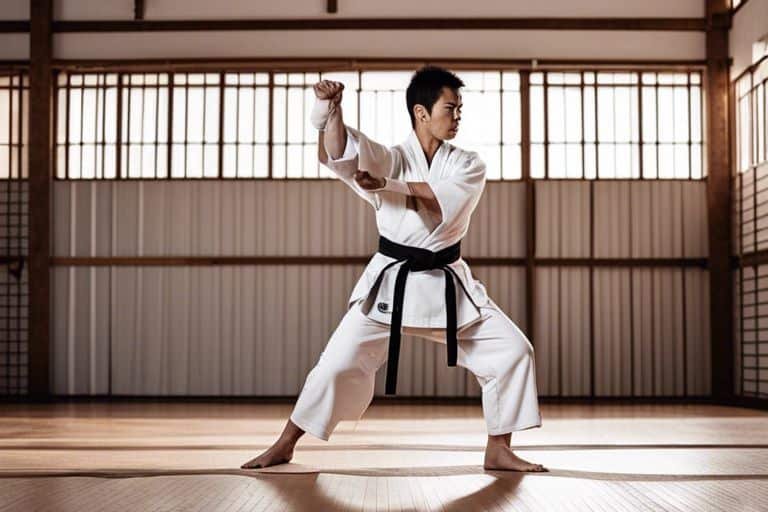Are you looking to improve your reaction times for sports, self-defence or everyday life? Kudo, a modern martial art, can help you achieve this goal. Kudo incorporates a wide range of dynamic movements and techniques that challenge your reflexes and response times. In our latest blog post, we delve into the ways in which practising Kudo can drastically improve your reaction times, ultimately helping you to be quicker and sharper in demanding situations. Read more at How To Improve Your Reaction Time Training.
Key Takeaways:
- Kudo can improve reaction times through its focus on fast, effective movements and responses, helping individuals to develop quicker reflexes.
- Regular practising kudo can lead to enhanced hand-eye coordination and mental alertness, allowing individuals to react more swiftly to stimuli.
- By engaging in kudo training, practitioners can improve their overall physical conditioning, including agility and speed, which can contribute to faster reaction times in various situations.
- Consistent kudo practice can also help individuals mentally train for faster reactions, as it requires ongoing concentration and awareness of opponents’ movements.
- Ultimately, integrating kudo into one’s fitness routine can have a positive impact on reaction times, benefiting both physical and mental abilities.
 I’m glad you’re interested in learning about the fundamentals of Kudo training, as it is an essential aspect of improving your reaction times. By understanding the core principles of Kudo, you will be better equipped to develop your skills and enhance your reflexes.
I’m glad you’re interested in learning about the fundamentals of Kudo training, as it is an essential aspect of improving your reaction times. By understanding the core principles of Kudo, you will be better equipped to develop your skills and enhance your reflexes.
Fundamentals of Kudo Training
Kihon – The Foundation of Techniques
In Kudo, “Kihon” refers to the fundamental techniques that form the basis of your training. These include striking, kicking, blocking, and grappling techniques. By practising Kihon, you will develop a strong foundation in the basic principles of combat, which will improve your ability to react quickly and effectively in various situations. Kihon also helps you build strength and flexibility, essential for executing swift, powerful movements.
Kata – Form and Fluidity to Enhance Reflexes
“Kata” in Kudo involves practising predetermined forms and sequences of movements. This training method improves your fluidity of motion and teaches you how to transition smoothly between techniques. By practising Kata, you will enhance your reflexes and muscle memory, allowing you to respond rapidly and instinctively to different stimuli. This helps you develop an automatic, efficient response to potential threats, ultimately improving your reaction times in combat scenarios.
By delving into the fundamentals of Kudo training, you are not only learning the essential techniques but also honing your reflexes and reactions. Mastering these core principles will significantly benefit your overall combat prowess and enable you to react swiftly and effectively in various situations. Remember, the key to success lies in consistent practice and dedication to refining your skills.
Reaction Time Enhancement Through Kudo
Practising Kudo can greatly enhance your reaction times in various situations. This is due to the nature of the martial art, which focuses on the application of practical techniques in real-life scenarios. By incorporating Kudo into your training regimen, you can develop quicker reflexes, improved decision-making abilities, and heightened situational awareness.
Kumite – Sparring Scenarios and Reaction Drills
In Kudo, kumite, or sparring, plays a crucial role in enhancing your reaction times. Engaging in controlled combat scenarios allows you to anticipate your opponent’s movements and react swiftly. This not only improves your defensive techniques but also trains you to respond effectively to unexpected attacks. By consistently practising kumite, you can condition your body and mind to react instinctively, sharpening your overall response times in high-pressure situations.
Conditioning and Reflex Training Exercises
Additionally, Kudo incorporates various conditioning and reflex training exercises that are specifically designed to enhance your reaction times. These exercises often simulate real-life combat scenarios, requiring you to respond quickly and accurately. By regularly engaging in these drills, you can strengthen your muscles, increase your agility, and cultivate heightened reflexes. The combination of physical conditioning and reflex training in Kudo can significantly improve your ability to react swiftly and effectively, giving you a distinct advantage in demanding situations.
Mental Preparedness in Kudo
When it comes to improving your reaction times in Kudo, mental preparedness is just as important as physical training. Your ability to stay focused and make split-second decisions can make all the difference in the heat of the moment.
Developing Focus and Anticipation
In Kudo, you need to be constantly aware of your surroundings and the movements of your opponent. This requires intense focus and the ability to anticipate their next move. By practising mindfulness and honing your ability to stay present in the moment, you can improve your reaction times and make quicker, more accurate decisions during a match.
Stress Management and Split-Second Decision Making
Kudo matches can be intense and high-pressure situations. It’s crucial to be able to manage stress effectively and make split-second decisions under duress. By training your mind to stay calm and composed, you can avoid the negative effects of stress on your reaction times and make swift, strategic choices that can give you the edge in a match.
Measuring Improvements
Now that you have been practising Kudo for a while, you might be wondering how you can measure the improvements in your reaction times. There are several methods you can use to track your progress and see the tangible results of your training.
Benchmarking Reaction Times Pre and Post-Training
One way to measure the improvements in your reaction times is by benchmarking your performance before you start Kudo training and comparing it to your performance after a few weeks or months of training. You can use simple reaction time tests, such as online tools or mobile apps, to measure your reaction times in milliseconds. By doing this, you can see the concrete improvements in your ability to react quickly to stimuli.
Using Technology to Track Progress
Another effective method for measuring improvements in your reaction times is by using technology to track your progress. There are high-tech devices and software available that can provide you with detailed data on your reaction times, including your average response time, variability in reaction times, and any specific areas where you may need to improve. Utilising technology in this way can give you valuable insights into your performance and help you set specific targets for further improvement.
How Can Practising Kudo Improve My Reaction Times?
With this in mind, you can see that practising Kudo can significantly improve your reaction times. The fast-paced nature of this martial art requires quick reflexes and split-second decision making, which can transfer to other areas of your life, including gaming. By consistently training in Kudo, you are honing your ability to react swiftly and accurately, ultimately enhancing your overall reaction times. If you’re looking for more tips to increase your reaction time for gaming, check out Tips to increase your reaction time for gaming.
FAQ
Q: How can practising Kudo improve my reaction times?
A: Kudo incorporates both striking and grappling techniques, which helps to improve overall coordination and reaction times. By practising the various movements and techniques, you can train your body to react quickly and effectively in different situations.
Q: How often should I practice Kudo to see improvements in my reaction times?
A: Consistent practice is key to seeing improvements in reaction times. It is recommended to practice Kudo at least 2-3 times a week to see noticeable improvements in reaction times over time.
Q: Can Kudo help with my reflexes as well?
A: Yes, Kudo training involves fast-paced movements and drills that can help improve reflexes. Through regular practice, participants can develop heightened reflexes, enabling them to react swiftly to various stimuli.
Q: Are there specific drills in Kudo that are designed to improve reaction times?
A: Yes, Kudo includes specific drills such as striking pads, partner drills, and sparring exercises that are designed to enhance reaction times. These drills focus on improving the speed and accuracy of movements, leading to better reaction times.
Q: Can Kudo training benefit those in sports or professions that require quick reactions?
A: Yes, the skills acquired through Kudo training can be beneficial for athletes, martial artists, and individuals in professions that require quick reactions, such as law enforcement or military personnel. The improved reaction times and reflexes can be transferable to a wide range of activities and scenarios.
Q: Is Kudo suitable for all ages and fitness levels to improve reaction times?
A: Kudo can be adapted to suit individuals of various ages and fitness levels. Whether you are a beginner or experienced practitioner, the training can be tailored to help improve your reaction times through incremental progression and personalised coaching.
Q: Are there any additional benefits to practising Kudo besides improving reaction times?
A: In addition to enhancing reaction times, Kudo training offers a full-body workout, improves cardiovascular fitness, builds mental resilience, and enhances self-defence skills. It provides a holistic approach to physical and mental well-being while also improving reaction times.



